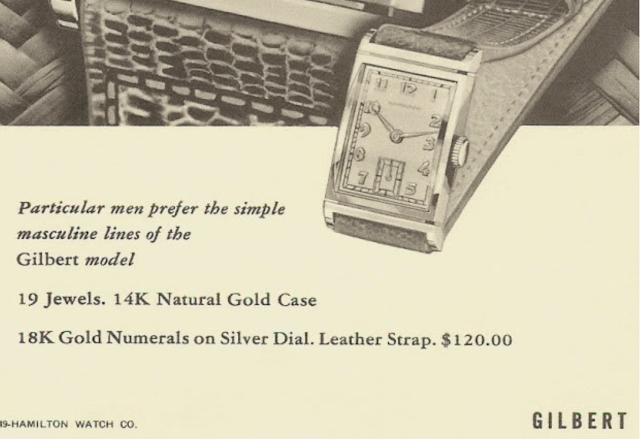
Sometimes you find watches that are head scratchers… is it legit? There aren’t a lot of “fake” Hamiltons but there are jeweler re-cased movements and the occasional “Hormilton” to contend with. A lot of things can happen to a watch over the decades.
The model I’m going to showcase is a 1951 Gilbert – the model was introduced in 1941 and one of a very few models to survive the WWII years and go into the 1950s. 1951 was the last year of production.
The Gilbert was cased in solid 14K yellow gold. It featured a sterling silver dial with solid 18K gold numerals. One very interesting bit of trivia is in 1949 the catalog shows the Gilbert was also available with a luminous numerals and hands or with black numerals (and black hands, I presume). I have NEVER seen those two options in the wild though – so if you happen to have one, let me know.
My project watch is clearly a Gilbert but if you look closely you’ll see the dial features numerals and square markers. By the looks of it, it’s been quite a long time since this watch had a trip to the spa.
With the bezel removed, you can get a closer look at the dial. I don’t see a notch on the side so it’s possible it’s an original dial that is super dirty.
The inside of the case back is clearly marked Gilbert so there’s no mystery there. The movement inside is a correct 982M caliber with 19 jewels. By this time (1951) the 982M had lost it’s gold medallion in the train bridge and got an engraved circled M.
The back of the dial has no markings whatsoever. So this is clearly an original dial.
Another model from the time period, the Keith, has a very similar dial.
I have what I believe is a refinished Keith dial and looking at the margins of the minute track relative to the edges of the dial, the Gilbert dial is clearly smaller. So I don’t think my project watch has a Keith dial.
The back of the case back is engraved with a presentation for “over a quarter century” service and looks to be a classic example of an Awards Division watch. The Awards Division produced watches with slight variations to production watches so the recipients wouldn’t see their award for sale in their local jewelry store.
Everything is cleaned and dried and ready to be reassembled.
The watch is ticking away with a nice motion. Lets see what the timer has to say.
It’s a little slow but that’s not a big deal. The amplitude is great, thanks to the white alloy mainspring that it came with. The beat error of 7.8ms is way to high for me to let go. So I’ll have to try to adjust it.
Ugh! Someone in the past must have lost the hairspring stud screw and they put in a replacement that was almost impossible to remove. It took quite a while for me to back it out enough to remove the balance. I could then remove the screw and replace it with a proper sized screw.
After about four attempts I was able to get the beat error down to 1.2ms. Now to adjust the beat rate and speed it up.
With the last adjustments finished the watch is now running great. No complaints here.
The finished project has a new glass crystal and a nice black leather strap. This is a very interesting example of a Gilbert. I think the dial is legit – it’s original and fits the bezel opening perfectly. I don’t know if it’s a one of a kind but it may be limited to only awards watches or even employees of the company – the Ohio Edison Company.













